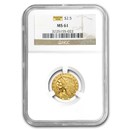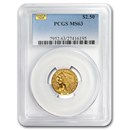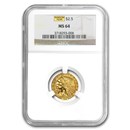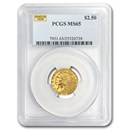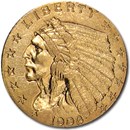$2.50 Indian Quarter Eagle Coins (1908-1929)
Top Pick
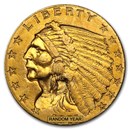
$2.50 Indian Gold Quarter Eagle (Cleaned)
$428.68
| Quantity | Check/Wire |
|---|---|
| 1 - 9 | $438.68 |
| 10 - 24 | $433.68 |
| 25 + | $428.68 |
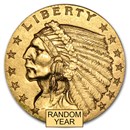
$2.50 Indian Gold Quarter Eagle XF (Random Year)
$478.68
| Quantity | Check/Wire |
|---|---|
| 1 - 9 | $488.68 |
| 10 - 24 | $483.68 |
| 25 + | $478.68 |
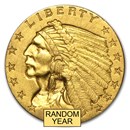
$2.50 Indian Gold Quarter Eagle AU (Random Year)
$488.68
| Quantity | Check/Wire |
|---|---|
| 1 - 9 | $498.68 |
| 10 - 24 | $493.68 |
| 25 + | $488.68 |

$2.50 Indian Gold Quarter Eagle BU (Random Year)
$508.68
| Quantity | Check/Wire |
|---|---|
| 1 - 9 | $518.68 |
| 10 - 24 | $513.68 |
| 25 + | $508.68 |

1908 $2.50 Indian Gold Quarter Eagle PR-66 PCGS CAC (Bass Jr.)
$49,995.00

| Grade | Mintage | Population |
|---|---|---|
| 236 | 15 |

1911 $2.50 Indian Gold Quarter Eagle MS-64+ NGC CAC (Strong D)
$32,995.00

| Grade | Mintage | Population |
|---|---|---|
| N/A | 25 |
Rare Pick

1911-D $2.50 Indian Gold Quarter Eagle AU-58 NGC
$6,559.00

| Grade | Mintage | Population |
|---|---|---|
| 55,680 | 1,514 |
New

1911-D $2.50 Indian Gold Quarter Eagle MS-62 NGC (Strong D)
$8,889.00

| Grade | Mintage | Population |
|---|---|---|
| N/A | 961 |

1911-D $2.50 Indian Gold Quarter Eagle MS-65 PCGS (Strong D)
$88,995.00

| Grade | Mintage | Population |
|---|---|---|
| 55,600 | 30 |

1911-D $2.50 Indian Gold Quarter Eagle MS-65 PCGS CAC (Strong D)
$94,495.00

| Grade | Mintage | Population |
|---|---|---|
| 55,600 | 30 |
New

1911-D $2.50 Indian Gold Quarter Eagle AU-50 PCGS (Strong-D)
$4,309.00

| Grade | Mintage | Population |
|---|---|---|
| 55,600 | 296 |
Sale

1912 $2.50 Indian Gold Quarter Eagle MS-65 PCGS
$11,495.00
$11,995.00

| Grade | Mintage | Population |
|---|---|---|
| 616,000 | 104 |
New

1913 $2.50 Indian Head Gold Quarter Eagle MS-62 NGC
$769.00

| Grade | Mintage | Population |
|---|---|---|
| 722,000 | 4,609 |
New

1913 $2.50 Indian Gold Quarter Eagle MS-64+ PCGS CAC
$4,449.00

| Grade | Mintage | Population |
|---|---|---|
| 722,000 | 82 |
Rare Pick

1914-D $2.50 Indian Gold Quarter Eagle MS-65 NGC
$16,495.00

| Grade | Mintage | Population |
|---|---|---|
| 448,000 | 55 |
About The $2.50 Indian Head Quarter Eagle Coin
The $2.50 Indian Head Quarter Eagle is a gold coin the United States government minted from 1908 to 1929. The coin features a unique design by sculptor Bela Lyon Pratt, an Augustus Saint-Gaudens student.The obverse of the coin features the profile of a Native American chief in full headdress, with the date below. The coin's reverse features a standing eagle with outstretched wings, clutching arrows, and an olive branch in its talons. The eagle is surrounded by the "2 1/2 DOLLARS" denomination and the national motto, "IN GOD WE TRUST."
The coin is made of 90% gold and 10% copper, with a weight of 4.18 grams and a diameter of 18 mm. It has a face value of $2.50, but its gold content gives it a much higher intrinsic value.
The $2.50 Indian Head Quarter Eagle was minted at four locations: Philadelphia, Denver, San Francisco, and Carson City. Some rare and valuable coin versions include those minted at Carson City, which has the "CC" mint mark.
The $2.50 Indian Head Quarter Eagle is a highly collectible and valuable coin among U.S. gold coin collectors as well as gold investors.
History Of The $2.50 Indian Head Quarter Eagle Coin
The $2.50 Indian Head Quarter Eagle was introduced in 1908, shortly after the United States government redesigned its gold coinage to give it a more modern and artistic look. The design was the work of sculptor Bela Lyon Pratt, who had won a competition held by the government in their search to create a new look for the nation's gold coins.One of the notable features of the $2.50 Indian Head Quarter Eagle is its unique incuse design, which means that the design elements are recessed into the surface of the coin rather than raised above it. This was a departure from the traditional design style of American coins, making the $2.50 Indian Head Quarter Eagle stand out from other currencies.
The coin was minted from 1908 to 1915. After a pause it was minted again from 1925 to 1929. The mintage numbers were relatively low compared to other United States coins of the era, which makes the $2.50 Indian Head Quarter Eagle a rare and valuable coin today.
During its production, the $2.50 Indian Head Quarter Eagle underwent some changes in design. In 1915, the rim was raised slightly and the coin's relief was reduced to improve the striking process. In 1925, the appearance was modified again to include the motto "E PLURIBUS UNUM" on the reverse.
The $2.50 Indian Head Quarter Eagle was also affected by the gold recall of 1933, which required Americans to turn in their gold coins to the government in exchange for paper money. It can be difficult to strike coins with high relief designs. This resulted in the melting down of many $2.50 Indian Head Quarter Eagles, which makes the surviving coins even rarer today.
The $2.50 Indian Head Quarter Eagle is an exciting and essential piece of American coinage history, with a unique design and a fascinating backstory.
Explore the value of U.S. coins and find the value of average circulated and uncirculated $2.50 gold Quarter Eagles.
Check out what other customers are saying.


